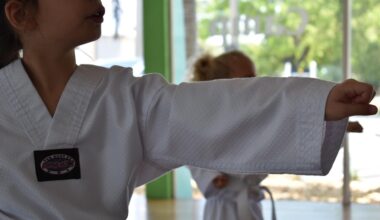Functional Balance Exercises for Daily Life in Week 31
Balancing your workout routine with functional exercises is essential for improving day-to-day activities. Balance training focuses on gaining strength, mobility, and stability, which enhances your overall physical performance. By engaging in these activities, you’ll combat the risks associated with falls and injuries. Simple movements like standing on one leg or performing heel-to-toe walks can significantly improve your core stability. Consider incorporating balance exercises into your weekly workout plan not only for resilience but also for greater agility. Additionally, you can engage in activities such as yoga or Pilates, both of which emphasize body control and balance. These practices not only enhance strength but also promote mental well-being. Aim to incorporate these exercises three to four times a week to maximize their benefits. Always ensure you’re warmed up before starting any balance-focused activities to prepare your body and prevent injuries. Staying consistent is key as improvement will come gradually. Before starting any new routine, consider consulting with a fitness professional or physical therapist to ensure you practice these exercises safely and effectively.
Balance training can be both fun and rewarding, especially when paired with social activities. Consider joining group classes that emphasize balance enhancement. Many gyms offer specialized sessions focused on stability training. These classes often incorporate resistance bands, stability balls, and balance boards to make the workouts more engaging. For instance, performing lunges on a balance board not only challenges your strength but also tests your equilibrium. Scavenger hunts or outdoor balance challenges in parks can be ideal for family fun while improving your stability. Always prioritize your form when doing these exercises to get the most out of each movement. Originally designed for athletes, balance training is essential for everyone, regardless of age or fitness level. Incorporate exercises like single-leg deadlifts or tree pose to develop control gradually. Do remember to monitor your body’s response and adjust your sessions accordingly. This is an effective way to ensure you’re not over-exerting yourself while challenging your abilities. Balancing fun and functionality helps sustain your motivation and ultimately leads to long-term adherence to your workout plan.
Simple Balance Exercises for Everyone
There are several simple balance exercises that anyone can incorporate into their routine. Starting with basic standing yoga poses can help improve your stability. Try postures like the Warrior III and Tree Pose, which challenge your center of gravity and require focus. Additionally, consider integrating movements that mimic daily activities, such as reaching or bending. Standing on a BOSU ball can help you build strength and balance simultaneously. For added resistance, engage in weighted activities while focusing on your balance. Squatting while holding weights requires core engagement, enhancing your overall stability. You can also practice standing on one foot for increased strength in your legs and feet. Gradually increase the duration as you gain confidence. Don’t forget to engage your core during balance movements to provide additional support. Aim to hold your movements for longer, focusing on breathing and mindfulness. This awareness during your functional training ensures you get the maximum benefits while decreasing the risk of injuries. As these exercises become easier, challenge yourself by closing your eyes to further disrupt your balance.
Functional balance exercises are vital for improving athletic performance and everyday activities. Whether you’re walking, climbing stairs, or playing with children, these movements enhance your ability to perform effectively and safely. When engaging in balance-focused workouts, think about your alignment and posture. This consideration increases the effectiveness of your exercises and forms a solid foundation for injury prevention. Different activities, such as Tai Chi, highlight the importance of slow, controlled movements that enhance balance while promoting relaxation. Relaxation techniques integrated within these workouts can help reduce stress, fostering a more enjoyable training experience. To heighten your workout intensity, add dynamic movements, like lunges combined with arm swings. Creating this combination helps target multiple muscle groups while enhancing stability. Try engaging in challenges like standing on one leg while throwing a ball back and forth with a partner. This multitasking can be enjoyable and reinforce your body’s balance capabilities effectively. Always be mindful of your limits and progress at your own pace. Establishing a balanced routine encourages you to remain committed and achieves functional fitness.
Assess Your Balance Improvements
Tracking your progress is essential for motivation and improvement in your workout routine. Consider ways to assess your balance achievements. You can use a simple scale from 1 to 10 to gauge your confidence in various exercises. By maintaining a journal, you can record not only your scores but also feelings about each workout session. Include additional notes on how you felt regarding stability and strength during your practice. You may also wish to utilize technology; many fitness apps provide features to track physical performance over time. Regularly revisit your earlier assessments to identify growth. Consider performing distinct balance tests, such as standing on one leg or timed challenges, to quantify your improvements more accurately. Share your goals with others, as accountability can enhance motivation and provide opportunities for support. You can also engage in friendly competition with family members or friends. Remember, balance training is a lifelong journey; improvements may be gradual, but consistency leads to significant gains. Celebrate small victories, as this encourages you to continue on the path to improved functionality.
Focusing on balance in your workout routine not only improves physical capabilities but also fosters mental wellness. The mindfulness aspect gained through balance training can significantly elevate your overall mood and mindset. Engaging in mindful breathing during each exercise can enhance concentration. After a successful balance session, you may feel more grounded and stable throughout daily life. Maintaining mental focus is essential, especially when challenging your body’s limits. Regularly incorporating balance exercises boosts confidence, reducing anxiety linked to falls and instability. Furthermore, participate in community fitness events centered on balance and strength. Many local areas host challenges or workshops specifically aimed at fostering functional skills. This participation can provide camaraderie and accountability while enhancing personal achievement. Such events emphasize the importance of community support in achieving fitness goals. Remember, the journey toward improved balance is ongoing and unique to each individual. Continually adjust your routine according to how your capabilities evolve. Approach your functional training with an open mind and enjoy the process as much as the results. This mindset makes every progress step worthwhile.
Integration of Functional Balance Exercises in Daily Life
Integrating functional balance exercises into your daily activities has lasting benefits. Simple actions, like standing while brushing your teeth, can enhance core stability naturally. Balancing on one leg while waiting in lines can further improve your strength and focus without feeling forced. Replacing sedentary habits with dynamic movements can enhance your fitness. Aim to incorporate short balance breaks during your day. These pauses can consist of standing on tiptoes, heel-toe walks, or other variations. Consider using fitness routines that include functional balance as part of your outdoor activities, like hiking. Nature walks can also be beneficial due to uneven terrain that naturally challenges your balance. Daily activities transform into opportunities for improving stability with this integrated approach. Your workouts don’t need to be lengthy; even short sessions can yield impressive results when done consistently. Look for chances to maintain an active lifestyle while balancing recreational activities. As you integrate these activities, observe how your life changes positively. Enhance both mental and physical endurance for all-around functional improvements as you embark on your balance journey.
In conclusion, balance training is vital at all fitness levels and ages. Designing a workout plan that incorporates functional balance exercises supports a healthier, happier lifestyle. Remember that consistency is key. Prioritize developing a routine that works for you and fits seamlessly into your lifestyle. Be patient with yourself as you progress and celebrate all accomplishments, no matter how small. There’s no need to rush; balance takes time and dedication. Focus on gradual improvements and enjoy the journey along the way. Adapt exercises to fit your unique needs and comfort levels, and don’t hesitate to seek guidance from fitness trainers if necessary. Balance provides not just physical benefits but also psychological advantages that positively impact your mental health. With regular practice, you’ll notice enhanced stability, greater confidence, and a heightened sense of well-being. Challenge yourself regularly while reflecting on your achievements and journey throughout your training. As you commit to enhancing your balance, you enhance your quality of life overall. Remember, every small step you take counts toward achieving significant progress over time.


